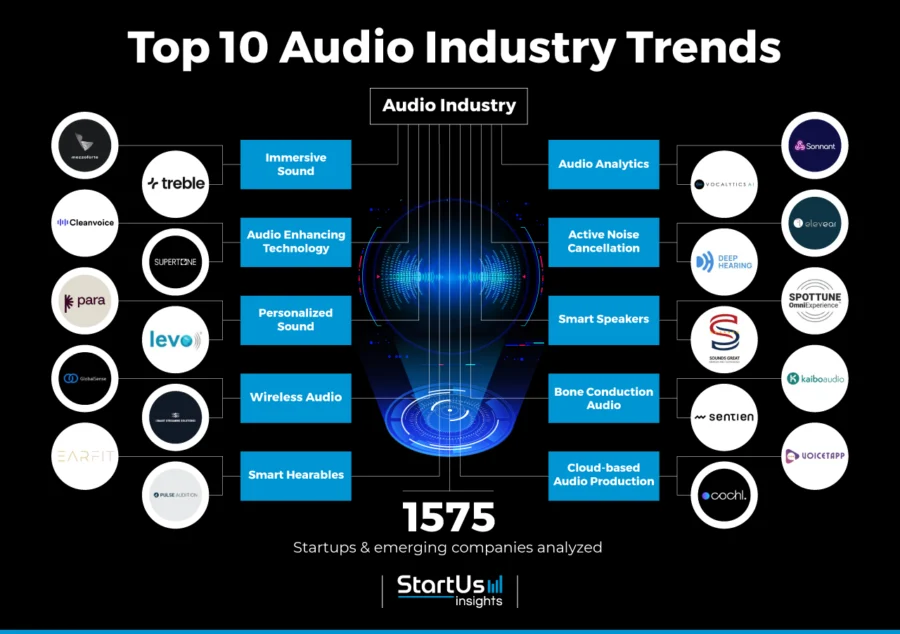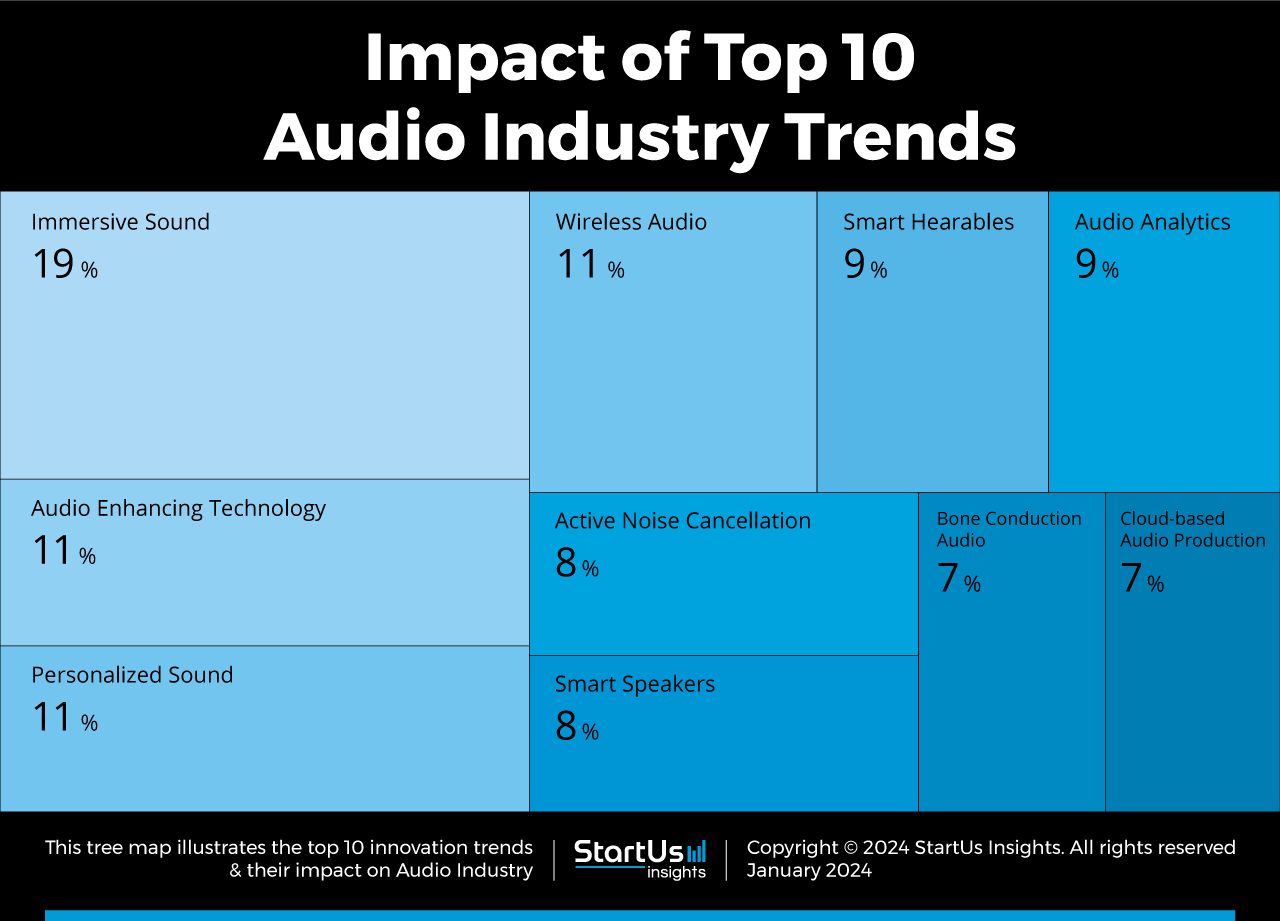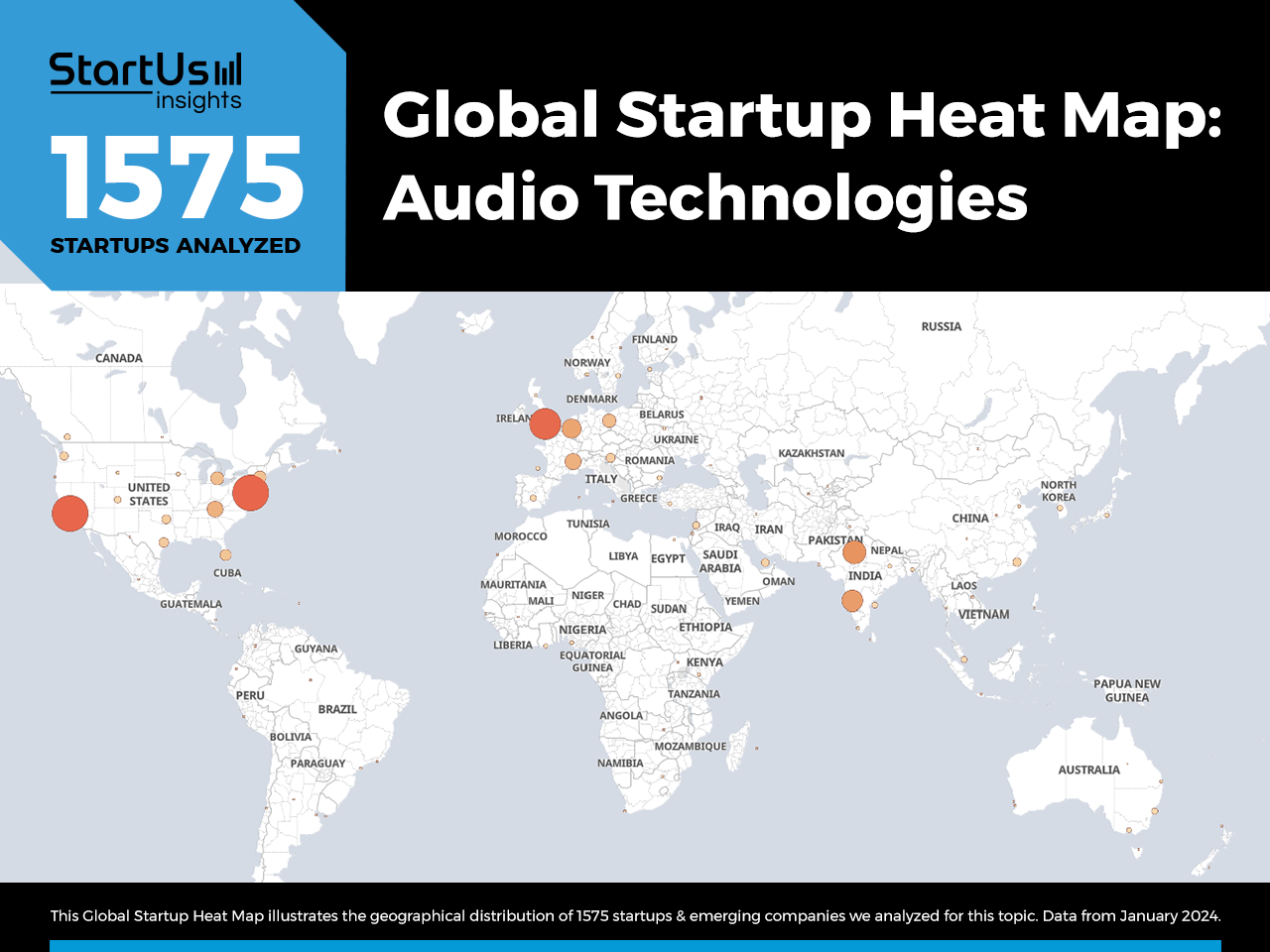Accelerate Productivity in 2025
Reignite Growth Despite the Global Slowdown
The recent innovations in sound technology allow for enhanced sound quality and new immersive listening experiences. The sound and audio realm is transforming profoundly, driven by smart speakers, voice assistants, spatial audio, and AI-powered sound manipulation. These emerging tech-driven audio industry trends are blurring the boundaries between the physical and digital realms, redefining the perception and interaction with sound. Sound technology tackles the challenge of unclear audio while effectively eliminating distracting background noise, ultimately enhancing the quality of entertainment and communication experiences.
Top 10 Audio Industry Trends in 2025
- Immersive Sound
- Audio Enhancing Technology
- Personalized Sound
- Wireless Audio
- Smart Hearables
- Audio Analytics
- Active Noise Cancellation
- Smart Speakers
- Bone Conduction Audio
- Cloud-based Audio Production
Methodology: How We Created the Audio Industry Trend Report
For our trend reports, we leverage our proprietary StartUs Insights Discovery Platform, covering 5M+ global startups, 20K technologies & trends plus 150M+ patents, news articles, and market reports.
Creating a report involves approximately 40 hours of analysis. We evaluate our own startup data and complement these insights with external research, including industry reports, news articles, and market analyses. This process enables us to identify the most impactful and innovative trends in the audio industry.
For each trend, we select two exemplary startups that meet the following criteria:
- Relevance: Their product, technology, or solution aligns with the trend.
- Founding Year: Established between 2020 and 2025.
- Company Size: A maximum of 200 employees.
- Location: Specific geographic considerations.
This approach ensures our reports provide reliable, actionable insights into the audio industry innovation ecosystem while highlighting startups driving technological advancements in the industry.
Innovation Map outlines the Top 10 Audio Industry Trends & 20 Promising Startups
For this in-depth research on the Top Audio Trends & Startups, we analyzed a sample of 1500+ global startups & scaleups. The Audio Innovation Map created from this data-driven research helps you improve strategic decision-making by giving you a comprehensive overview of the audio industry trends & startups that impact your company.
Tree Map reveals the Impact of the Top Audio Industry Trends in 2025
The sound technology landscape is changing due to growing trends such as immersive sound, enhanced audio, and personalized soundscapes. Immersive sound and spatial audio take the audience into virtual worlds, providing a more realistic audio experience. Moreover, the industry is leveraging audio enhancement technology and noise cancellation to ensure high-resolution and crystal-clear audio reproduction.
Global Startup Heat Map covers 1575 Audio Technology Startups & Scaleups
The Global Startup Heat Map showcases the distribution of 1500+ audio exemplary startups and scaleups analyzed using the StartUs Insights Discovery Platform. It highlights high startup activity in the US, the UK, and India. From these, 20 promising startups are featured below, selected based on factors like founding year, location, and funding.
Want to Explore Audio Innovations & Trends?
Top 10 Emerging Trends in the Audio Industry [2025 and beyond]
1. Immersive Sound
Immersive sound enables sound engineers to create realistic 3D sound experiences for the audience. This technology makes virtual surroundings more participatory and engaging by enabling listeners to hear sounds originating from specific directions. It finds use in a wide range of applications, mainly in movies, video games, and virtual reality (VR). Further, integrating wireless audio with immersive technologies such as AR and VR is revolutionizing the way we interact with multimedia information.
Startups develop surround sound technologies that interpret sound as 3D objects to create a more immersive sound experience. Moreover, spatial audio, also known as 3D audio, is gaining popularity in sound production and mixing for VR and AR applications. It utilizes advanced algorithms to create a realistic sound field that surrounds the listener, enhancing the sense of immersion in various media.
The global 3D audio market size is expected to be worth around USD 17.22 billion by 2033, from USD 5.8 billion in 2023, growing at a CAGR of 11.5% during the forecast period from 2024 to 2033.

Credit: Market.US
MezzoForte offers Immersive 3D Audio Experiences
French startup MezzoForte creates immersive audio for museums, concerts, live shows, performance venues, and tourist places. It develops a cloud platform that allows users to access immersive experiences by leveraging automatic localization based on GPS and ultra-wideband (UWB) indoor positioning.
Further, the startup utilizes sound processing and editing techniques based on machine learning, sound perception, and cognitive neuroscience to create realistic 3D audio scenes and spatial audio effects. MezzoForte allows creators and composers to orchestrate immersive augmented performances by merging acoustic sources, loudspeakers, and bone conduction technology.
Treble enables Virtual Sound Simulation
Iceland-based startup Treble develops a sound simulation platform that enables designers and engineers to optimize their sound systems, eliminate design guesswork, and avoid costly mistakes. By leveraging wave-based simulations, users simulate the interaction between the sound system and the venue with high accuracy.
The technology also enables virtual prototyping and synthetic audio generation. Further, the startup offers spatial audio technology for digital twins and virtual worlds. The startup’s solution generates immersive audio-visual virtual listening experiences for users to experience an intuitive feeling of the performance.
2. Audio Enhancing Technology
Audio degradation is a pervasive problem in the digital era, affecting all from vintage recordings to online streaming. Audio enhancement technologies enable sound engineers to restore lost details and natural timbre, minimize noise, and bring back forgotten audio treasures. This growing trend is redefining how people experience audio content.
For this, audio tech companies harness AI to enhance the quality of low-resolution or degraded audio recordings by converting them into clear soundscapes. Further, they use deep learning algorithms and neural networks to learn from vast amounts of datasets of high-resolution audio to understand patterns between the sound components to reconstruct missing information in degraded recordings. Audio-enhancing technology further empowers musicians to restore their old recordings with crystal clear audio, and filmmakers to enhance their audio archives.
AI-powered sound systems are becoming increasingly popular in consumer electronics, contributing to market growth.
Cleanvoice aids in Filler Sound Removal
Romanian startup Cleanvoice provides an automated podcast editing tool to remove common artifacts from podcasts and audio files. The artifacts include filler sounds, stuttering, mouth sounds, and dead air from audio recordings. The tool leverages AI to detect and eliminate unwanted sounds, empty words, and inconvenient babbling.
Further, the AI is multilingual and supports a variety of accents which allows it to transcribe and mix podcasts. It takes into account every audio track and edits them, keeping the audience engaged through enhanced audio quality. Cleanvoice allows audio editors to improve the recordings, have more control, and save time while editing.
Supertone provides a Voice Separator
South Korean startup Supertone offers a real-time voice separator audio plugin for music and film producers. The solution utilizes neural network models to separate audio into three distinct intuitive channels – ambiance, voice, and voice reverb.
These channels allow filmmakers to instantly control the clarity of the voice, offer the highest performance, and minimize artifacts in the results. This, in turn, aids in expressive singing, speech synthesis, unique voice design, and enhanced speech quality.
3. Personalized Sound
Conventional audio systems offer a standardized experience, thus failing to address individual preferences. Sound personalization solutions bridge this gap by tailoring audio to the listener. This technology revolutionizes audio experiences by customizing sounds based on user preferences, listening environment, and hearing sensitivities. This ensures optimal sound quality and enjoyment. Startups leverage psychoacoustic and room acoustics modelings to create such personalized sound from sound perception and analyze the acoustics properties of a listening environment.
Further, machine learning refines personalized audio profiles using AI algorithms to analyze listener preferences and data. For instance, personalized audio solutions enable healthcare providers to create personalized audio therapies that aid in hearing rehabilitation and combat tinnitus. Additionally, they allow audio engineers to produce personalized audio mixing, which enhances creative freedom and optimizes sound for specific audiences.
Apple‘s Personalized Spatial Audio features use the iPhone’s TrueDepth camera to create a 3D map of the user’s ears in less than a minute. Active users of music streaming services are projected to increase from 793 million in 2024 to 884 million in 2025.
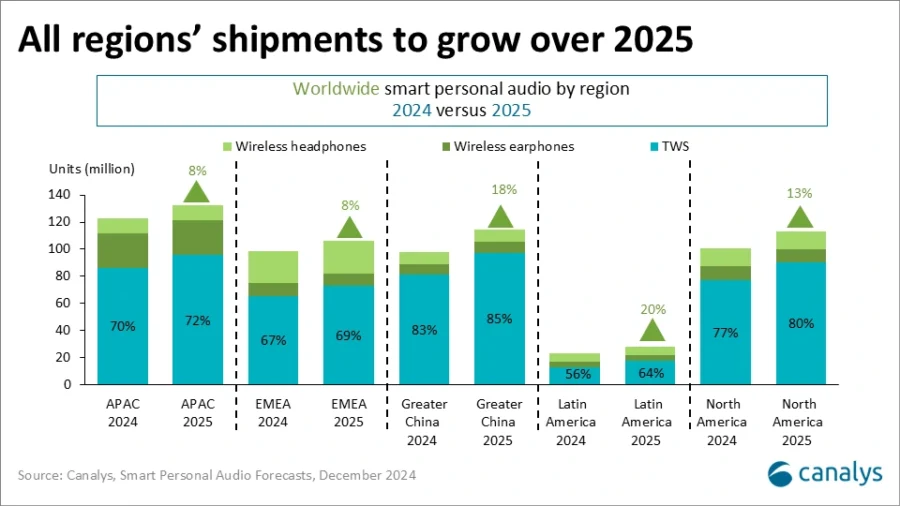
Credit: Canalys
Para enables Personalized Voice Messaging
US-based startup Para creates a personalized audio messaging platform for brands to ensure robust customer interactions using human-like synthetic voices. This solution combines AI and natural language processing (NLP) to generate lifelike voices and personalize audio content to ensure more meaningful engagement.
Further, the solution allows brands to enhance their marketing efforts by personalizing voice marketing campaigns as real conversations. Para’s audio messaging builds stronger connections with the audience and creates a unique brand identity, thereby enhancing the overall customer experience.
Levo Medical specializes in Personalized Sound Therapy
US-based startup Levo Medical provides personalized sound therapy tools for healthcare providers to treat tinnitus patients. Through neural habituation, sound therapy harnesses the brain’s cognitive abilities to reduce tinnitus symptoms and therefore improve the quality of life for patients.
Moreover, Levo Medical leverages smart devices such as iPod or iPad to deliver personalized tinnitus sounds, so it learns to ignore the hissing or buzzing. The company’s assessment and tracker tool provides real-time feedback, which helps healthcare providers modify therapy based on patients’ progress, leading to more successful outcomes and increased reach.
4. Wireless Audio
The simplification of the signal chain extends to wireless connectivity, facilitating a smooth transition between headphones and wireless devices. Wireless audio eliminates the limitations associated with physical cables and traditional wired audio setups, gaining popularity among users and enthusiasts. Startups thus employ communication technologies such as Bluetooth and Wi-Fi to enable high-quality audio transmission with minimized latency and interference.
Wireless audio solutions further allow for audio streaming to speakers or headphones to create a more streamlined and portable audio experience. Utilizing wireless tech, audio streaming is accessible over low-energy radios that allow for enhanced battery life and device longevity. Moreover, the support for audio broadcast is integrated into Bluetooth LE Audio for multi-stream operation and enables hearing aids to connect to venue audio.
Wireless multi-channel audio systems (WMAS) are being developed to revolutionize large events by combining microphones, in-ears, and remote control in a single broadband radio frequency (RF) channel.
The global Bluetooth audio codec market size is projected to grow at a CAGR of 5.8% between 2024 and 2032.

Credit: Research and Markets
GlobalSense activates Wireless Instant Alerts
US-based startup GlobalSense enables wireless instant alerts for enhanced vehicle security using embedded AI. These alerts instantly notify users of attempted threats through Wi-Fi-connected devices, thus increasing awareness and enhancing vehicle safety standards. The startup also develops customized sound-based machine learning models that are more cost-effective than traditional AI platforms.
The startup further specializes in smart sensing mechanisms tailored to acoustic event detection, monitoring, predictive maintenance, computer vision, and more. With this technology, users fine-tune sensitivity settings to enable event detection capability that fits with the environment and specific preferences.
Smart Streaming Solutions provides a Low Latency Audio Engine
German startup Smart Streaming Solutions offers low-latency audio over Wi-Fi for guide tour companies. The startup provides a portable Wi-Fi device that enables guests to connect with tour guides and receive low-latency audio.
Further, the audio engine ensures smooth real-time audio, reduces the need for third-party equipment, and minimizes logistical costs and technical inconvenience. This assists brands in efficiently offering low-latency audio experiences, saving costs, and boosting revenues.
5. Smart Hearables
As wearable technology evolves, audio engineers need to consider audio quality and efficiency as well as design audio experiences for these devices. There is a growing demand for a hands-free audio experience by eliminating the need for separate headphones and speakers. Startups thus create wearables such as smart watches, AR glasses, and audio glasses driven by advancements in miniaturization, battery technology, and artificial intelligence. These technologies enable the integration of audio processing, personalized sound algorithms, and voice control into lightweight wearable devices.
Moreover, the emergence of intelligent assistants enhances the usability of wearables, enabling users to access information seamlessly. Smart wearables integrate sound technology to add features like voice assistants, noise cancellation, or personalized sounds for enhanced user experience. Using smart hearables, brands aim to create unique soundscapes and immersive audio experiences.
Some smart hearables also measure pulse and heart rate more accurately than many smartwatches. It is also known to save lives by calling for help in emergencies when they detect life-threatening biometric data.
Earfit offers 3D-Printed Smart Earmolds
Turkish startup Earfit produces customized 3D-printed earmolds combined with automatic modeling algorithms for hearing aids. The startup combines acoustic engineering techniques and additive manufacturing to achieve maximum comfort and high-quality sound. Additionally, the automated production process is controlled by computer programs that enable product design based on wearer preferences.
Moreover, the startup’s AI ensures noise isolation and noise cancellation for musicians, audio engineers, and audiophiles, allowing them to hear crucial audio cues while minimizing excessive noise levels. The technology enables users to hear hidden details in the music, thus making it an immersive sound experience for the audience.
Pulse Audition makes Intelligent Audio Glasses
French startup Pulse Audition manufactures smart audio glasses for hearing aids in noisy environments. The startup utilizes hearing systems equipped with AI and intuitive controls to enhance speech intelligibility and select the optimal sound mode for the surroundings. Further, its audio glasses are equipped with direction-sensing sensors and omnidirectional microphones to capture sound through 360°.
Moreover, the startup’s audio glasses leverage bone conduction technology to transmit sounds through the glass temples, ensuring an open ear canal. These audio glasses allow businesses, event organizers, and healthcare providers to enhance their understanding while communicating with other stakeholders.

6. Audio Analytics
The intersection of signal processing, machine learning, and acoustics is enabling sound analytics to unlock information from the auditory environment. Audio technology companies develop sound analytics platforms and sensors that enable real-time sound monitoring to identify issues or opportunities.
Deep learning algorithms further extract crucial insights from sound data to proactively detect irregularities in audio data, such as malfunctioning equipment, unexpected acoustic disturbances, or security incidents. For instance, healthcare providers are able to easily detect signs of distress or changes in condition by monitoring patient sounds. Moreover, such solutions utilize sentiment analysis to collect real-time feedback for brands to improve customer service, product development, or marketing strategies.
Audio advertising is also a growing trend within the audio analytics sector. The global audio advertising market is expected to expand at a CAGR of 6.02%, from USD 38.157 billion in 2025 to account at USD 51.110 billion in 2030.
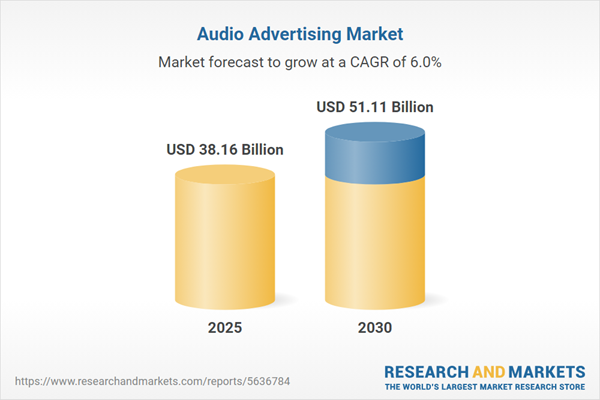
Credit: Reseach and Markets
Sonnant aids Audio Data Collection
US-based startup Sonnant leverages AI to structure and categorize audio data as well as organize multimedia content. It then utilizes NLP to analyze and summarize reports for enhanced engagement outcomes and improved advertising. The startup’s solution converts spoken words into data to automate management processes for cost savings.
Sonnant’s content management platform also assists businesses, broadcasters, podcasters, and radio stations to enhance audience engagement, maximize audio performance, and accelerate audio revenues.
Vocalytics develops Sound Analytics Software
US-based startup Vocalytics creates sound analytics software that listens to background noises. It enables real-time alerts for health, safety, and security through conversational intelligence. Further, it harnesses automatic speech recognition (ASR) to transcribe conversation, followed by the extraction of insights through NLP and natural language understanding (NLU).
Through advanced application programming interfaces (APIs), the startup turns connected microphone devices into intelligent acoustic sensors. Vocalytics AI allows organizations to extract actionable insights from every conversation, thereby streamlining reporting for operational efficiency and compliance.
7. Active Noise Cancellation
Active noise cancellation (ANC) tackles the challenge of background noise, which impedes focus, hinders productivity, and potentially compromises hearing health. Startups employ advanced algorithms and audio processors to generate anti-noise signals, thus providing a respite from unwanted sounds. Moreover, ANC effectively blocks out disruptive background noise, enabling users to work productively and protect their hearing.
By employing microphones to capture external sounds, ANC technologies generate opposing sound waves that cancel out the original noise. Startups offer ANC solutions for entertainment venues to deliver performances with minimal distractions. Moreover, such solutions enhance productivity, comfort, and operational efficiency. This makes them a valuable tool for businesses to improve operations and deliver unique experiences to the audience.
Elevear specializes in Noise Cancellation
German startup Elevear integrates noise reduction technology to hearables, headsets, and hearing aids. The technology eliminates the occlusion effect from hearable microphones, allowing users to perceive their voice and surrounding environment with clarity.
The idle noise reduction technology allows hearable manufacturers to produce high-performance products with low-cost components without compromising the clarity of sound. Further, it improves listening comfort and natural communication, maximizing the overall user experience.
Deep Hearing improves Noise Reduction
South Korean startup Deep Hearing eliminates noise and howling to enhance the conversation experience. The startup integrates device noise reduction and low-powered voice activity detection algorithms into semiconductor chips for small wearables, thus lowering the power consumption of audio processing. Moreover, Deep Hearing allows organizations to conduct video conferencing without surrounding speaker sounds, thus enabling accurate communication.
8. Smart Speakers
Smart speakers are a significant trend in the audio industry, characterized by their integration of advanced technology and convenience. These devices combine high-quality audio playback with voice recognition and AI-powered assistants to control music, access information, and manage smart home devices through voice commands.
The trend reflects a growing consumer preference for interconnected, hands-free, and personalized experiences in home entertainment and daily tasks. Smart speakers also represent a shift towards more intelligent and interactive home environments, as they often serve as central hubs for controlling various smart devices.
The global home audio equipment market size was valued at USD 28.5 billion in 2024 and is projected to grow from USD 33.2 billion in 2025 to reach USD 89.5 billion by 2033, growing at a CAGR of 10.6% over the forecast period (2025–2033).
Spottune makes a Wireless 360° Broadcast Speaker
Spottune is a Danish startup that manufactures wireless smart speakers with omnidirectional 3D acoustics to guarantee immersive room-filling sound. The wireless speakers have a clean cylindrical shape, designed to integrate into an existing infrastructure, saving installation costs and eliminating bulky cables.
Further, its acoustic opening enables high-frequency sounds to be evenly distributed in all room spaces. Moreover, the solution creates low-frequency tones at high volumes, ensuring a smooth and distortion-free listening experience. Spottune addresses the challenge of unclear sounds in crowded areas such as retail stores.
Sounds Great provides a Semiconductor Dynamic Speaker
Taiwanese startup Sounds Great implements semiconductor technology to speakers for high-quality audio output and to prevent hearing impairment. The startup utilizes its enhanced motion microchips to replace traditional voice coils to deliver premium stereo sound quality to compact devices.
Field sharing and circulation enhancement are other technologies used by the startup to produce semiconductor speakers. The solution thus eliminates the traditional fine-tuning process, which is time-consuming and expensive.
9. Bone Conduction Audio
Bone conduction audio is an emerging approach to audio delivery that enhances customer experience. In contrast to traditional earbuds and headphones that block the ear canal, bone conduction audio transmits sound directly to the inner ear via vibrations. By keeping open ears, workers thus maintain vigilance of their surroundings, effectively diminishing the likelihood of accidents and augmenting comprehensive safety measures.
Bone conduction audio utilizes transducers or piezoelectric actuators that transform electrical signals into vibrations, efficiently conveying audio data straight to the inner ear without blocking the ear canal. Moreover, this technology enables precise sound delivery and allows concurrent background noise perception. Startups innovate to ensure hearing protection and safety in industries like manufacturing, construction, and healthcare.
Some bone conduction devices can be surgically implanted into the skull bone as a medical solution for certain types of hearing loss.
Kaibo Audio offers BCT Transducers
US-based startup Kaibo Audio designs bone-conduction headphones for both comfort and safety while maintaining high-quality audio. The BCT transducers are equipped with dual noise-canceling microphones to enable crystal-clear audio. Further, it utilizes a cladding approach to effectively eliminate sound leakage, keeping conversations private.
Kaibo utilizes true wireless stereo technology to deliver a lifelike and immersive sound experience, with distinct left and right channels simulating a surround sound environment. The BCT headphones empower businesses to streamline communication and collaboration by enabling effortless hands-free calls and video conferencing, eliminating distractions and fostering clear communication.
Sentien designs Bone-Conduction Headphones
Czech startup Sentien produces wearable open-ear bone conduction headsets that conduct sound directly to the inner ear. This technology merges offline and online realities and, therefore, allows users to remain aware of the surrounding sounds. The open-ear headset is instantly accessible through voice and intuitive gesture commands.
Moreover, Sentien develops an app that allows users to customize up to 12 touch or gesture controls to suit their preferences. This solution minimizes sound leakage as well as delivers a personalized listening experience. It is equipped with two noise-reduction microphones to deliver high call quality. The startup enables organizations, manufacturers, and other stakeholders to improve operational efficiency through enhanced communication.
10. Cloud-based Audio Production
Cloud-based audio production enables audio engineers to collaborate on projects in real time and work remotely. The COVID-19 pandemic significantly accelerated the adoption of remote recording due to travel restrictions. Companies are leveraging cloud-based technology to further facilitate remote recording sessions when musicians and audio engineers are located in different countries globally.
Such cloud engines operate in a virtualized environment optimized for low latency throughput that supports real-time audio processing and mixing. The cloud-based platforms and low-latency audio streaming technologies deliver novel opportunities for real-time collaboration across different locations. Further, sound engineers use cloud storage to ensure the security and protection of sensitive audio files.
Voicetapp provides AI-powered Speech-Text Converter
UK-based startup Voicetapp builds an AI-driven platform suitable for content creation and management. The platform provides speech-to-text transcription, AI content writing, AI voiceover, and AI-powered YouTube-to-blog conversion. It uses AI technologies and is easy to use, multilingual, accurate, and fast.
The platform also provides note-taking, caption generation, content creation, and SEO optimization. It is suitable for a wide range of users, from content creators and marketers to businesses expanding their global reach.
Cochl enables Cloud-based Sound Recognition
US-based startup Cochl offers a sound recognition solution that analyzes acoustic sounds with precision and accuracy. This AI system operates on both cloud and edge in real time. The machine listening system comprehends a broader range of sounds, thereby approaching the level of auditory perception humans possess.
Cochl also equips computers with the ability to perceive and interpret acoustic signals, enabling them to understand their surroundings. It analyzes ambient sounds to further identify patterns and anomalies, enabling businesses to anticipate potential security threats or equipment failures before they occur.
Discover all Audio Industry Trends, Technologies & Startups
The future of sound technology looks promising with innovative trends to reshape audio experiences in commercial and personal domains. We anticipate further captivating advances in sound control and wireless technology to enhance auditory experiences, boost productivity, and create new entertainment opportunities. Wireless earbuds, smart speakers, AR, and VR audio are further expected to create a more immersive and connected environment.
The Audio Industry Trends & Startups outlined in this report only scratch the surface of trends that we identified during our data-driven innovation & startup scouting process. Identifying new opportunities & emerging technologies to implement into your business goes a long way in gaining a competitive advantage.


